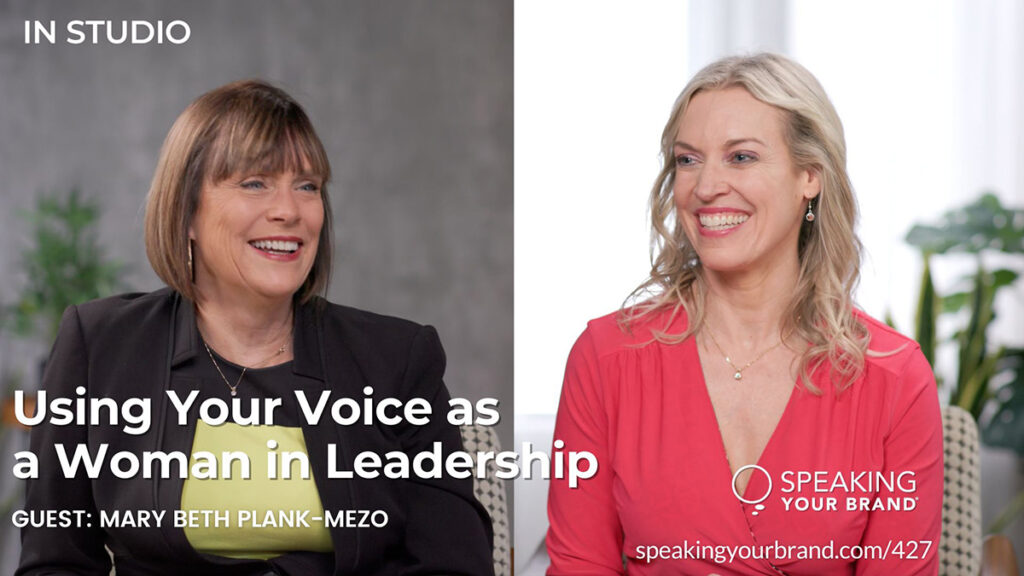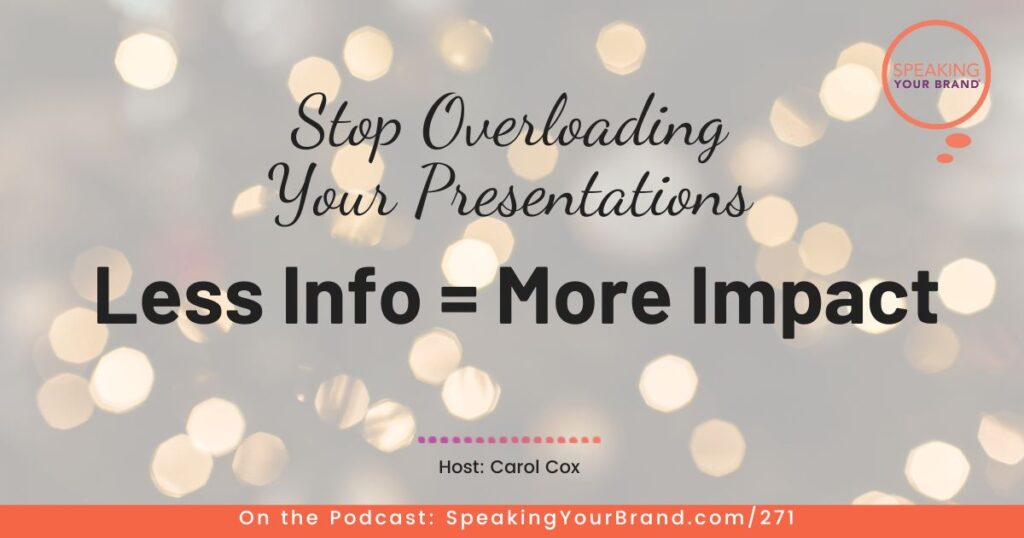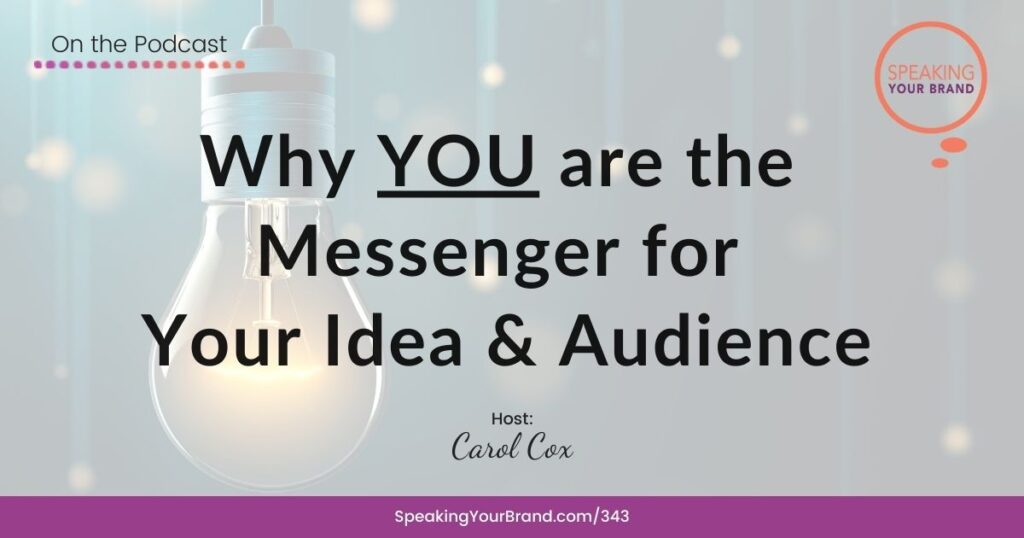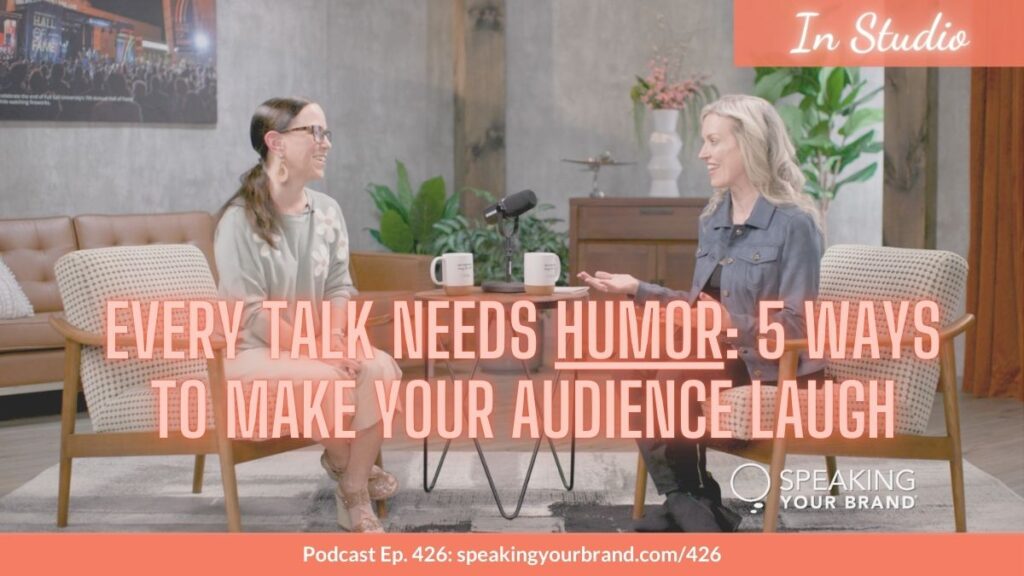Why I No Longer “Teach from the Stage” with Carol Cox: Podcast Ep. 392
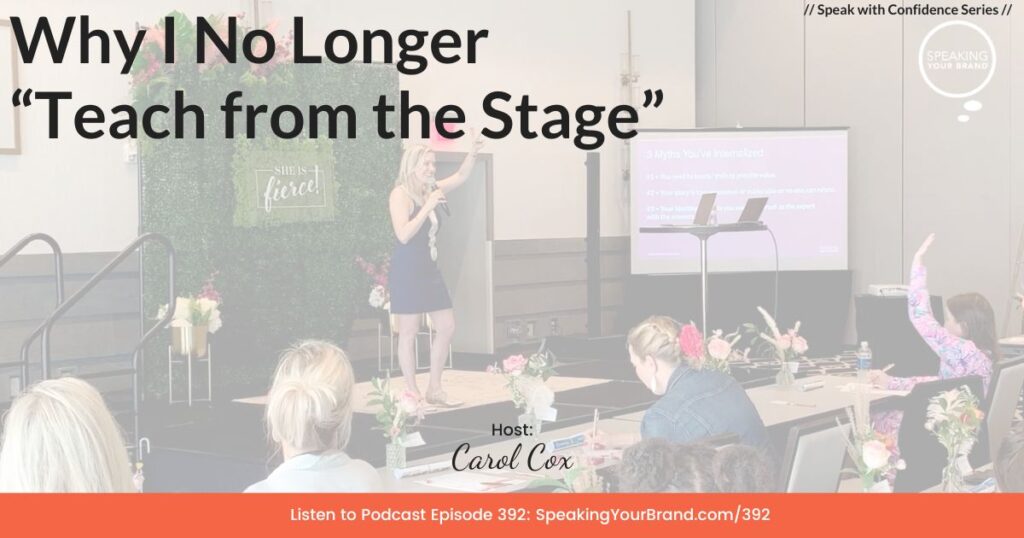
Subscribe to the podcast!
My goal with this current podcast series called “Speak with Confidence” is to boost your confidence by getting you to think differently about speaking, whether it’s getting comfortable with impromptu speaking (episode 390) or claiming your identity as a speaker (episode 391).
I know you want to be an impactful speaker, to share your important message with your audiences, and attract clients for your business.
We *think* that teaching and training is what our audiences want. This is what I thought too.
But, I believe that there are trends going on around us that are changing this. We’re all swimming in information; and now with AI, we have comprehensive answers in just a few seconds.
This is why I no longer advocate “Teaching from the stage”.
I’m going to share in this episode what I recommend instead.
About Us: The Speaking Your Brand podcast is hosted by Carol Cox. At Speaking Your Brand, we help women entrepreneurs and professionals clarify their brand message and story, create their signature talks, and develop their thought leadership platforms. Our mission is to get more women in positions of influence and power because it’s through women’s stories, voices, and visibility that we challenge the status quo and change existing systems. Check out our coaching programs at https://www.speakingyourbrand.com.
Links:
Show notes at https://www.speakingyourbrand.com/392/
Discover your Speaker Archetype by taking our free quiz at https://www.speakingyourbrand.com/quiz/
Enroll in our Thought Leader Academy: https://www.speakingyourbrand.com/academy/
Connect on LinkedIn: https://www.linkedin.com/in/carolcox
Related Podcast Episodes:
- Episode 382: 3 Signs You’re Stuck in the Expert Trap with Your Public Speaking
- Episode 362: [Case Study] Integrating Thought Leadership and Lead Generation in Your Signature Talk with Danielle Hayden
- Episode 355: What a Signature Talk Is and What It Should be Doing for You
392-SYB-Solo-Teaching-v2.mp3: Audio automatically transcribed by Sonix
392-SYB-Solo-Teaching-v2.mp3: this mp3 audio file was automatically transcribed by Sonix with the best speech-to-text algorithms. This transcript may contain errors.
Carol Cox:
Hear why I no longer teach from the stage, and what I recommend instead on this episode of the Speaking Your Brand podcast. More and more women are making an impact by starting businesses, running for office and speaking up for what matters. With my background as a TV political analyst, entrepreneur and speaker, I interview and coach purpose driven women to shape their brands, grow their companies, and become recognized as influencers in their field. This is speaking your brand, your place to learn how to persuasively communicate your message to your audience. Welcome to the Speaking Your Brand podcast. I’m your host, Carol Cox. We’re continuing our new series called speak With Confidence. Last week’s episode was all about claiming your identity as a speaker, and the week prior was on developing your impromptu speaking skills. My goal with this series is to get you to think differently about speaking than you have, because I know you want to be an impactful speaker, to share your important message with your audiences, and to attract clients for your business. And we think that teaching and training is what our audiences want. Now, this is what I thought too, for a long time, but I believe that there are trends going on around us that are changing this, changing this expectation from our audiences. Because after all, we’re all swimming in information, all the podcasts that we listen to, the online content that we read from social media posts to videos to news.
Carol Cox:
And now with artificial intelligence, we can have comprehensive answers to any question that we have, whether it’s simple or complex in a matter of a few seconds. This is why I no longer advocate what is called teaching from the stage. I’m going to share on this episode what I recommend instead. Now, I know that there are many of you out there who enjoy teaching and training, and if you’re doing workshops, especially paid workshops for a group, an organization or a company, then absolutely you need to be teaching and training to the attendees in that audience. What I’m talking about here, when I’m saying teaching from the stage and switching, that is where you’re doing lunch and learns at a business group, you’re doing conference breakout sessions, you’re doing keynotes, and you’re doing TEDx style talks. Now, I know that so many of you like to teach and train because our most popular response and our speaker archetype quiz is what I’ve called the Stellar Scholar. The Stellar Scholar loves to get into all the details about their topic. They love to share what they know about their topic with their audience. And absolutely you should. But I want you to rethink and reframe the content that you’re sharing with your audience. I want you to think more about thought leadership and less about teaching and training. Now, if you’re curious to find out if you are the stellar scholar archetype or if you’re a different one of our four speaker archetypes, you can take our free quiz at Speaking your brand.com/quiz.
Carol Cox:
It’s ten multiple choice questions. It only takes a few minutes and you’ll get your results right away. Again, that you can take our free quiz as speaking your brand.com/quiz. Now let’s get on with the show. When I started speaking to brand as a business in 2015, the very first thing I did as a revenue producing activity was I hosted a half day workshop partnering with a local women’s entrepreneurship group. So they marketed the workshop to their audience, to their members, and then the members registered and signed up and paid for this half day workshop. And during this workshop, I taught them this idea of teaching from the stage instead of selling from the stage. Now, in that era, the 20 tens, this was an excellent strategy. Conferences were telling speakers that they absolutely were not allowed to sell from the stage. And you’ll still hear that when you submit to conferences, they’ll tell you, no selling from the stage. And I absolutely understand why event organizers don’t want their speakers selling from the stage, because speakers, a lot of speakers got to the point where they were just pitching their programs, their paid programs to the audience instead of actually sharing valuable information with them. And so I started to think, okay, so if as speakers, we can’t sell from the stage, and again, I agree, I don’t I wouldn’t want to do that.
Carol Cox:
How can we still stand out and attract clients from the speaking engagements that we’re doing, especially because a lot of speakers are doing speaking for lead generation. So by being the go to expert, by teaching what you knew, that was the way to attract clients. After all, event organizers always say that they want tangible takeaways, that they want their speakers to provide the audience with tactical, strategic tips and takeaways that they can use. And as audiences, we’re used to being students with our notebooks, diligently taking notes ready for the test at the end. But of course, guess what? There is no test at the end of a conference breakout session or a business lunch and learn. So as speakers, what exactly are we doing there for our audiences now? Interestingly, at this workshop that I delivered back in 2015, I still have the slides and I still have the workbook that I had prepared for that. And I went over at the time three act story structure and storytelling. So the core elements that I’ve been sharing with you all in this podcast and the work that we do with our clients, all those core elements were there from the very beginning, but my framing has changed. How I see the purpose of our role as speakers has changed, not only because of my development as a speaking coach, but also because of these trends that I see with all of the online information and now artificial intelligence that our audiences have.
Carol Cox:
So what exactly is wrong with this idea of teaching from the stage? As I mentioned earlier, if you’re doing a workshop that is that is the expectation and that’s the appropriate learning environment, you generally have enough time, at least two hours, sometimes four hours or an entire day. So as the expert, you’re teaching the attendees at the workshop something in particular, and you have the time and the space to do that. And the attendees know that that’s what they’re showing up for. They’re showing up with their notebooks ready to take notes because that’s what they’re there to learn. But if you’re presenting at a lunch and learn, or at a 30 minute session, at a monthly meeting of a business group, or you’re speaking at a conference breakout session, and this is definitely the case for a keynote, you’re actually not there to teach the audience. Now, you most likely have 30 minutes, maybe 45 minutes with the audience. That’s really not enough time to teach them something. You’re there instead to introduce something new, to get your audience to think differently about the topic, and to spark curiosity, to spark curiosity in the topic that you’re presenting, and also to spark curiosity in you. In you as that go to expert, in you as that service provider that they can work with.
Carol Cox:
I think back to some recent podcast episodes that I’ve done with clients. Danielle Hayden was on the podcast this past December talking about how when we work together in a VIP day to create her new signature talk, that we integrated thought leadership and planting sales seeds into her presentation. We completely reframe the content away from teaching and training and into thought leadership, and as a result, she has attracted more clients for her business than she ever has before. I think back to Terry DeLuca, who was on the podcast last summer of 2023, and the same thing when we work together on the Thought Leader Academy and her VIP day to create her talks, we really focused on storytelling and thought leadership. Instead of teaching and training in these speaking engagements that she’s doing, and she’s getting the best feedback, paid speaking engagements and attracting clients. Let me give you an example from two of my talks, and how I have reframed this idea of teaching from the stage. The first example is a 45 minute talk that I gave at a women’s event a couple of years ago. The topic was this idea of shifting from expert to thought leader, and during that talk, I. Centered my thought leadership framework. These layers that build your thought leadership, your expertise is at the bottom, then your big idea, then your personal story, and then the emotional courage to dig deep.
Carol Cox:
And as I explained in that talk and I’ve explained here on the podcast, most of us stop at the expertise. Maybe we’ll have a big idea, but most of us do not go to the personal story. And then definitely not digging really deep into the things that reveal more about who we are and by extension, then help the audience to understand themselves better. And that’s what I was doing in that talk. Helping the women in that audience understand themselves better, understand perhaps what was holding them back in their business or their career, or what they wanted to do as speakers because they weren’t stepping into thought leadership. I had examples from clients. I had cultural references. I asked questions of the audience, I got them participate. And really, my goal was to get them to think differently. And as a result of that talk, we got several thought Leader Academy clients because my talk sparked curiosity in them about this idea of thought leadership. And my talk sparked curiosity in me and the work that we do. Another example that comes to mind is the marketing AI conference that I spoke at last summer on Brand Voice and artificial intelligence. Now, this was a jam packed presentation about 45 minutes. I think I had 60 slides, maybe more than that. I do like slides, and so I show plenty of examples of using ChatGPT to make sure that it reflects your brand voice and how to do that.
Carol Cox:
But I didn’t just do that. So it wasn’t just teaching them how to use ChatGPT in that way, because really, again, a conference session with over 100, 125 people in it where you only have 45 minutes, is not the way to actually teach something that they can go learn and apply. Instead, I wanted to get them to think differently about how artificial intelligence number one is going to impact our brand voice. Number two, how they can leverage artificial intelligence to actually understand their brand voice better. So I, I took the bird’s eye view of this. In addition to giving them specific examples, I also engaged the audience a lot with questions. I had props that were paddles. One side had a human, a smile emoji, the other side represented AI with the robot emoji. So lots of engagement and the feedback that I got from the attendees was that it was such an energetic and engaging presentation. They said it was excellent and really one of the best there. So I want you to think about for the presentations that you’re delivering, how can you get the audience to think differently about your topic? What is your thought leadership message? How can you spark curiosity in that topic and in you? And I also want you to think about what is the audience there for? As I mentioned, if you are doing a workshop, the attendees know they’re showing up.
Carol Cox:
They’re there to learn something in particular. But if you’re going to a conference as an attendee, I don’t know about you, but at a conference, yes, I’m there to learn new things, but I’m also there to socialize, to network, to meet new people, to kind of get the lay of the land. Like, what are what are different people doing related to that particular type of conference? What is what is the what are the industry trends? What are the things that are on people’s minds? So we’re there to socialize. We’re there to get the big picture. And really we’re also there to be entertained at their all conferences should be fun and we should be enjoying them as well. So if we’re not teaching from the stage anymore, what is it that we should be doing instead? And here’s what I recommend. And if you’ve been listening to this podcast a while, this is not going to surprise you. I want you to engage from the stage as a speaker. You are a leader and you hold space for the audience. When we work with our clients and our thought Leader Academy in the VIP days to create their signature talk in act one of our signature Talk Canvas framework, we really dig in into what is the audience want? What are their goals? What’s getting in the way that they see is getting in their way? And what do you see as the speaker, as the thought leader, as the expert in your industry? What do you see as really getting in the way? And what you’re doing there is you’re empathizing with your audience, you’re validating what they’re experiencing, and you’re providing them with the belief and the inspiration that the change that you’re presenting to them is possible.
Carol Cox:
As a speaker, you’re also presenting your idea. You’re presenting your journey of discovery. You’re helping the audience see and think about something differently and understand something. So understand your topic or understand themselves in a new way. You’re also creating an emotional connection with your audience. When you think about engaging from the stage instead of teaching from the stage, that emotional connection comes from going deep into your stories, going deep into those personal experiences you’ve had that have shaped who you are and why this topic, why this message matters for you. Right now, we’re working with some faculty members from the University of California to help them craft their Ted style talks that they’re going to be delivering on their academic research. So they only have ten minutes. And we know that they have to have a really strong through line to convey their research to a general audience. And of course, as academics, they are so well versed in their scholarship, in their research. And as we’re working with them, we want to make sure that those key points come across.
Carol Cox:
But we’re having them lead with story. We’re asking them questions like, why does this topic matter to you? Why did you pick this academic topic to research and of all the different ones in your field, and has been so fascinating to hear their stories about why this topic matters to them, and as soon as they answer those questions in our workshop, and as soon as they put that story into their outlines, all of a sudden the research comes to life. All of a sudden, as that general audience, I feel a connection to their topic and I care about their topic in a different way. The other thing with engaging from the stage is that it’s really about being present with your audience. They’re in the moment. It’s not about memorizing your entire 30 minute or 45 minute talk, making sure that you have every word and every turn of phrase perfect. Instead, it’s about a two way conversation with your audience. I really see speaking as a relationship between the speaker and the audience. I know this is kind of radical. It’s it’s very different from what a lot of speaking coaches and other people look at speaking as. But I really see this even me sharing this podcast content with you, I really feel like this is a two way conversation between me and you as the listener, even though I can’t see you and we’re not even doing this at the same time.
Carol Cox:
This is asynchronous communication, but is a relationship because I’m trying to understand what your goals are, what your challenges are, and how I can help you to get there. This is why I share stories, and I bring on our clients so that they can share their stories and their journeys as well. Now, thinking of speaking as a two way conversation doesn’t necessarily mean that your audience is talking out loud back to you. Now, of course they could. If you have the time and the space and the audience size is right and the venue is right, then you can absolutely ask questions and have the audience share back out loud. But even if they’re not talking out loud, it’s still a two way conversation. Are you asking reflective questions along the way? Are you having them pause and reflect? Are you pausing and letting points sink in? And are you shifting the mood as needed for your audience? Whether you need to add some humor to make it a little bit lighter. Maybe you need to bring the energy up because people are getting a little bit tired. Maybe you need to give a moment for something that’s a little bit heavier in your content. Are you truly listening and tuning in to the audience and what they need? That is your role as a speaker. That’s why it’s so much more important that you engage from the stage then that you teach from the stage.
Carol Cox:
As I’ve worked with hundreds of women over the years, I’ve seen that some of them are reluctant to call themselves speakers, which is what I talked about on last week’s episode. And I think part of this is because they truly want conversations and relationships. They don’t want to be what’s called the sage on the stage, spouting talking points and lecturing to their audience. And I completely understand that. I think back to this book from the 1990s by Deborah Tannen is called You Just Don’t Understand Women and Men in Conversation, and it was on the New York Times Best Seller list for nearly four years. And the reason I’m thinking about this is because there was an article written after the 2016 presidential election that talked about Hillary Clinton’s leadership style and her speaking style. And I’ll include a link to this article in the show notes. So a bit of reference Deborah Tannen’s work. And in her work, Deborah Tannen found that women tend to emphasize what she calls the rapport dimension of communication. Women want to know. Did a particular conversation bring us closer together or further apart? Whereas men tend to emphasize what is called the status dimension, did a conversation raise my status compared to yours? Now, of course, this is the broad brush women and men, so you can think about masculine and feminine qualities as well.
Carol Cox:
And so for men, talking is a way of changing status. If you make a great point or set the terms of the discussion, you win the conversation. It’s a competition. Listening, on the other hand, is a way of establishing rapport, of bringing people closer together. This is why I believe that we can give audiences more of what they want, not what we want. By making our talks a two way conversation, we can lean into this idea that we want to build rapport. We want to build relationships with our audiences, not that not have a status competition where we’re trying to seem like we’re better because we happen to be on the stage, or we happen to be standing in front of them. So as you think about your next speaking engagements, whether it’s in-person or virtual, I want you to really think about how can you truly engage the audience? How can you be present for them? How can you lead them? How can you listen to them while you’re presenting your content to them? I think this is really good to change the relationship you have with yourself as a speaker and the relationship that you have with your audiences. If you would like to work with us, you can enroll in our Thought Leader Academy. You can get all the details of speaking your Brand.com slash Academy. We also have a brand new live online workshop that we’re hosting all around.
Carol Cox:
Building your speaking confidence. You can get the details for that as speaking your Brand.com slash speaking workshop. Again, that’s speaking your brand.com/speaking-workshop. And all of these links are in the show notes, so you can click on them there. As a podcast listener you save $100 on this workshop. Use the coupon code podcast 100. That’s all together. No Spaces Podcast 100. During this online workshop, you’re going to learn how to use our signature Talk Canvas framework to prepare for any presentation, speech, or interview you have. Whether you have five minutes or you have five weeks to prepare, we really want you to get comfortable with impromptu speaking as well as prepared speaking. You’re also going to identify your key stories and learn how to tell a great story. That’s really going to help you to engage your audience and to connect with them in a deeper way. We’re also going to talk about the best ways to practice and prepare to lessen your nerves, and to deliver with confidence. You’ll get training, feedback, and coaching from us so that you can quickly develop your speaking skills. Again, get all the details of speaking your Brand.com slash speaking Dash workshop. We’re going to wrap up our speak with confidence next week with a short meditation and visualization I have for you that you can listen to before your speaking engagements. Until next time, thanks for listening.
Sonix is the world’s most advanced automated transcription, translation, and subtitling platform. Fast, accurate, and affordable.
Automatically convert your mp3 files to text (txt file), Microsoft Word (docx file), and SubRip Subtitle (srt file) in minutes.
Sonix has many features that you’d love including world-class support, automatic transcription software, transcribe multiple languages, automated subtitles, and easily transcribe your Zoom meetings. Try Sonix for free today.



